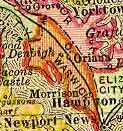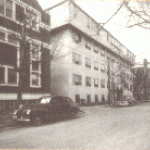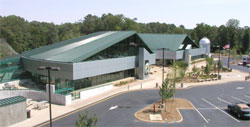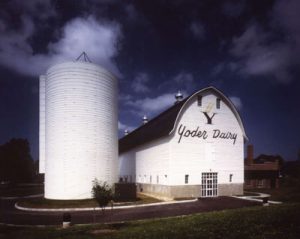Narrative Tour
You’re Virtually Here

First, a few facts about Newport News. While no one knows for sure how it got its name, most people think it was either because Captain Christopher Newport was a bearer of news to and from England or because, when he was cast away on Bermuda by the wreck of the Sea Venture, the news of his survival was received about the time he rounded the present Newport News Point. What we do know is that the city was chartered in 1896 and joined with Warwick County in 1958 to become the present narrow city which is almost 20 miles in length. Its population is about 190,000.
Let’s start our tour at the hospital. Riverside Regional Medical Center is the flagship

hospital of Riverside Health System. The Health System started with the 1915 charter for the “Newport News General and Non-Sectarian Hospital, Inc.” The original hospital contained 50 beds and was opened on Huntington Ave. north of 50th Street in 1916. A nursing school was started at about the same time. The hospital was severely strained by a typhoid epidemic during World War I, as well as the influenza epidemic of 1918-19. It was expanded considerably during World War II. The hospital moved to its current 56-acre location in 1963. It has 576 beds and is the primary center for medical care on the Virginia Peninsula. Its medical staff is comprised of over 400 physicians in 33 specialties. Riverside Regional Medical Center has always been an innovative force in medicine and medical education both locally and nationally, from the nation’s first CCU in 1965 to the country’s first web-based, competency-based evaluation system in 2001. It continues to evolve and improve and current capital projects include a 100 million dollar renovation project of the entire hospital.

Just past the hospital, you will see the Peninsula SPCA on the left side of J. Clyde Morris and the Virginia Living Museum on the right side. The latter is a very interesting combination native wildlife park, science museum, aquarium, botanical preserve, and planetarium. As you will see if you visit us, Newport News has many, many museums including: the Mariners Museum, the Peninsula (Civil War) Campaign Tour, the Army Transportation Museum, the War Memorial Museum of Virginia, the Peninsula Fine Arts Center, Newsome House, Lee Hall, and Endview Plantation, to name just a few.
Now let’s take a left on Jefferson Avenue. It’s very easy to get around in Newport News. Two streets run the entire length of the city (and continue in parallel westward through Williamsburg). As you can tell from a map, Newport News is a very long, narrow city. You can’t really get lost: if you’re not on Warwick or Jefferson, turn East or West, and you soon will be.
Westward on Jefferson, we begin to drive through the City Center of Oyster Point. It was an ammunition storage area during World War II but is now a technology and professional office park. Some of the turf-covered concrete ammo bunkers can still be seen today, and some have actually been converted into office space. Among the many physicians’ offices, law firms, real estate companies, and technology firms sits the Thomas Jefferson National Accelerator Facility, previously known as CEBAF. It is a very large continuous electron beam accelerator managed by the Southeastern Universities Research Association for the Department of Energy.
On the left-hand (western) side of Jefferson Ave. is Port Warwick, a residential/commercial/retail development area.
Would you like to read more about Newport News history? Let’s stop at the Barnes and

Noble in Yoder Plaza and we’ll get you a book (and I’ll get a Frappucino). This whole commercial area used to be a large Mennonite farm. The dairy barn and milk house is still here (although it was moved from its original site) and functions as a Fine Arts Center.
Our next stop is the Riverside Wellness and Fitness Center. On the way, we’ll pass Williamsburg/Newport News International Airport. This entire area, from the airport, past the Wellness Center, and towards Riverside Regional Convalescent Center was originally the 1700 acre Camp Patrick Henry, a staging area for World War II troops. All told, 1,412,107 soldiers were processed through the Camp during the War. The airport was developed for civilian use afterward and opened in 1949.
The Riverside Wellness and Fitness Center is a beautiful 70,000 sq. ft. facility that was opened as an integral part of the health system’s Wellness Division in 1982. It is one of the finest health centers in Virginia and contains an extremely large central exercise area with all types of electronic fitness equipment, an aerobics area, and a full-size basketball court. The center also has racquetball and handball courts, many indoor and outdoor tennis courts, and a large indoor pool. Child-care facilities are available, as well as nutrition and cardiac rehab services, massage therapy, exercise physiology expertise, and personal training services. Membership for you and your family is part of your employment benefits.
Leaving RWFC, we’ll continue west on Jefferson to the corner, and make a right on Denbigh. Several lights down we’ll take a right on Old Denbigh and turn into the grounds of The Gardens at Warwick Forest. This was built in 1985, was originally called Patrick Henry Hospital, then Patrick Henry Healthcare Center, and subsequently Riverside Regional Convalescent Center. It is the primary location for our nursing home geriatrics curriculum, and the adjacent Warwick Forest Retirement Community gives our residents further instruction in ambulatory geriatrics.
Let’s drive back out to Jefferson and go west again. Not far towards Williamsburg is Newport News Park, the largest municipal park east of the Mississippi. Historically, it is the location of one of Magruder’s lines of defense during the Civil War. By digging canals and constructing earthworks, the Confederates effectively delayed McClellan’s advance to Richmond. The park is on the site of the “real line of defense positions,” also known as the second defense, which ran from Fort Crawford on Mulberry Island (later Fort Eustis), up the Warwick River to Lee’s Mill, and on to Yorktown. The creeks, canals, and mill ponds eventually became the Newport News Reservoir, and the earthworks can still be seen in the park. There are multiple bike and hiking trails; boating, fishing, and canoeing; as well as a large campsite. This is also the site of the annual Celebration in Lights, one of the largest holiday light shows in the Southeast.
We’ll backtrack east along Jefferson but will take a right on Richneck Road. Immediately on the right (behind the elementary school) you will see “Charter Elm” or “Courthouse Elm“. It is said that this was the site of the first court sessions in Warwick County; justices held court there and conducted county business until the actual courthouse was built. Several members of the Cary family, one of Newport News earliest planter families, are buried under the tree. The ancient elm is commemorated on the Official City Seal of Newport News (along with the three Jamestown ships).
As we exit Richneck, we’ll turn right on Denbigh and, several blocks later, left on Warwick. On the way back towards the Family Practice Center, note Young’s Mill on the right side of Warwick. After passing Hidenwood, we’ll make a right on the Avenue of the Arts and see Christopher Newport University and their new “Ferguson Center for the Arts.” We will go down Shoe Lane and Riverside Drive to enjoy the beautiful homes along the James River.
As we continue along the river, we will drive around the back side of the Mariner’s Museum. In the distance, past the James River Bridge, you can see the Northrop Grumman Newport News Shipbuilding. No tour would be complete without a little information about the shipyard. It was started by a man named Collis P. Huntington, who had started his fortune selling groceries and supplies to miners in the California Gold Rush. He had a vision of a transcontinental railroad and, after deciding the Atlantic terminus would be in Newport News, he bought up land and right-of-ways from the Peninsula west to Richmond and beyond. The coal business flourished after the Civil War, and Mr. Huntington soon realized that a shipyard would be very useful to repair his coal ships. It was started in 1886, and a rather rough town continued to grow up around the coal yards and shipyard. He hired an architect to lay out Newport News and it was granted a city charter by the Virginia General Assembly in January 1896. The shipyard earned U.S. Navy contracts right from the beginning and has continued to be one of the most active shipbuilders for the U.S. The shipyard has grown to become the second largest employer in the Commonwealth of Virginia.
On our left is the grounds of the Mariners’ Museum. It was started in 1931 by Mr. Huntington’s son and daughter-in-law, Archer M. and Anna Hyatt Huntington. The latter was an accomplished sculptress, and on our left, you can see the statue (Conquering the Wild) she did in tribute to her father-in-law. We will cross the “Lions Bridge,” named for the Lions she sculpted on each end, which extends over a dam the couple constructed on Waters Creek in 1932 to form Lake Maury. The Mariner’s Museum is the premier maritime museum in the World.
We will continue along the James River until we enter Hilton Village. It was built by the Federal Government during World War I to house shipyard workers and their families. The streets are named after shipyard and city administrators of the time. It is a beautiful neighborhood with wide, tree-lined streets and charming, English-style homes.
As we turn back onto Main Street, we will cross back over Warwick Boulevard. On the right is the Main Street Library, one branch of the large, extensive, Newport News Public Library System. Duck under the railroad bridge, and we’re at the Riverside Hilton Medical Complex which is the new home for the Riverside Medical Library and the Riverside School of Nursing. Keep going straight to the traffic light and turn left onto Jefferson Avenue. Go about half a mile and the VCU Riverside Family Medicine Residency is located in the Riverside Brentwood Medical Center on your right. To make the loop complete, keep going straight on Jefferson Avenue for 2.3 miles until you get to the intersection of Jefferson and J. Clyde and turn left on J. Clyde. Go down approximately half a mile and the hospital will be on your left.
We certainly hope you’ve enjoyed this “virtual tour.” You can’t get the full flavor of this beautiful city over the internet, that’s why we hope you’ll visit us in person!
Although we’ve linked to some of these above, here are some other links relating to Newport News and Hampton Roads:
- Virginia
- City of Newport News
- Newport News Visitor’s Guide
- Christopher Newport University
- Newport New/Williamsburg International Airport
- Virginia Living Museum
- The Mariner’s Museum
- Riverside Health Systems
- The Daily Press
- Hampton
- Hampton University
- Old Dominion University
- Norfolk International Airport
- Virginia Beach
- The Virginian Pilot
- Williamsburg
- Colonial Williamsburg
- College of William and Mary
- Jamestown
- Virtual Jamestown
- Yorktown
- Colonial National Historic Park
- Busch Gardens
- Water Country USA
- Chesapeake Bay Bridge Tunnel
